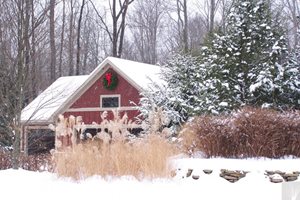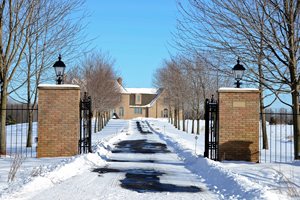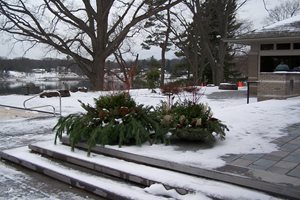Seasonal Landscape Maintenance
How to prepare your garden for winter during summer and fallThough preparing your landscape for winter may seem like a lot of work, "it's a cheap form of insurance on your investment in the landscaping," says Andrew Morse of Belknap Landscape Co., Inc in Gilford, NH. Winterization starts in summer with ongoing maintenance tasks like sealing your pathways, continues in fall when winter is imminent, and should be revisited in spring to make sure your landscape is ready to grow.
Summer winterization
There are a few general maintenance tasks which should be done during the warmth of summer that protect your landscaping from winter's harsh extremes.
Seal hardscaping.
The most important thing to do in summer is to reseal walkways, driveways, and patios. "The melt/ freeze/ thaw cycle is hard on porous surfaces such as concrete," says Joe Markell of Sunrise Landscape and Design in Sterling, VA. You can choose from sealants which have a wet look, matte, or a natural finish.
Paint or seal decks, arbors, and other wood in the landscape.
Wood has a tendency to soak up water, which makes it dangerously slippery to walk on and also reduces its lifespan in the landscape. If your wooden structures need refreshing, make sure you get to them before winter to prevent long-term damage.
Use asphalt to fill cracks.
"If water gets into a crack and freezes, your path, patio or driveway can heave," says Markell. Summer's the time to check for any new cracks or spaces that may have formed.
Check for rusting metal.
If left throughout the damp winter, rusting metal can leave a stain on decks or patios. Check metal closures, patio furniture, barbecues, and garden tools such as hoses to make sure there are no rusting parts that may leave a stain.
Apply sandpaper tape to wooden steps.
While it's best to avoid wood on areas where you'll need to walk in winter, you can make wooden steps somewhat less slippery by applying strips of sandpaper tape to give your feet something to grip on.
Fall winterization
With winter on its way, it's smart to batten down the hatches and make sure your landscape is prepared for the first storm.
Winterize the lawn.
"Cut the lawn shorter than normal to reduce the chance of fungus problems overwintering," says Morse. "Long grass flops over in the snow and can shelter insects or fungal disease." Rake up leaf litter for the same reason.
Blow out the irrigation system.
Landscapers offer a service where they use a commercial blower to push all of the water out of your irrigation system. If water remains in the system, the pipes and sprinkler heads can shatter during periods of sustained below-freezing weather.
Cover patio furniture.
You can either bring patio furniture inside for the winter, or purchase ready-made covers which will protect them from rain and snow.
Clean gutters.
Make sure all gutters are clean and downspouts are clear so the water can flow out and away from the house. Ice dams at the base of downspouts can cause water to flow into your home, so it's a good idea to connect a pipe to the bottom of each downspout and direct water to a drainage system.
Tidy up the garden.
"Winter plants are so showy that the landscape looks much more attractive when old foliage and finished perennials are cleared away," says Markell. "If you don't clean up, plants can become moldy and create havens for field mice."
Protect delicate plants.
"We build wooden teepee structures to protect brittle plants growing under the eave lines, so snow doesn't crush them," says Morse. He also wraps plants with breathable fabric and sprays some plants with an anti-desiccant such as Wilt-Pruf.
Winterize the outdoor kitchen and hose bibs.
"Any pipes leading to an outdoor sink should be treated just like an outdoor hose bib," says Kyle Ritchie of Milieu Design LLC in Wheeling, IL. "Turn off the water at the source, then turn on the faucet so the water can drain." Then, shut off any gas lines and unplug electrical items like outdoor fridges or wine coolers.
Partially drain aboveground ponds.
While ponds with moving water or a heater can likely run all year, aboveground ponds may need to be partially drained so the freeze/ thaw cycle doesn't damage stonework around the edges. Drain and remove aboveground pumps, but any pumps submerged in the pond will take much longer to freeze and so may be safe, depending on your climate.
Cover and partially drain the pool.
Partially drain the swimming pool to prevent damage from the freeze/ thaw cycle, add winter chemicals to the pool, and cover the pool to keep debris out. Winterizing a pool is best done by a pool professional to make sure there's no damage to pumps or the pool structure itself.
Spring startups
Harsh winter weather as well as the occasional errant snow shovel can cause damage to your landscaping that isn't apparent until spring, so doing a quick garden checkup is an important last step in making sure your garden's ready to grow.
Irrigation startups.
Your landscaper will turn on the system, check for any broken sprinkler heads or leaks, and replace any delicate instruments such as the backflow preventer that may have been brought indoors for winter.
Remove patio furniture covers and "stage" the garden again.
Once the rains have stopped, it's safe to take the covers off of your patio furniture, even if it's too chilly to want to sit out there. The view of a beautifully-decorated landscape can be as enjoyable as actually using the space.
Unwrap plants.
If you've wrapped any plants with burlap or other breathable fabric to protect them for winter, be sure to remove the fabric by the end of March. "You'll want to take the fabric off before it gets too warm, so plants can begin to grow again," says Morse.
Refill ponds and pools.
Both ponds and pools can be refilled once the temperatures warm up again. They may need to be treated for algae growth, which is common over the winter.

 Backyards
Backyards
 Front Yards
Front Yards





